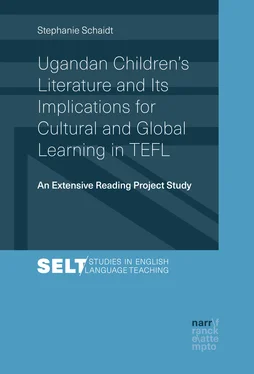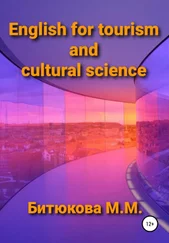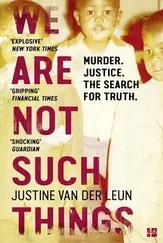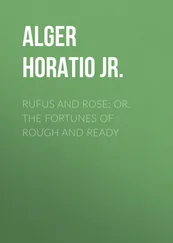Following Hallet, the limitations of single literary texts have repeatedly been pointed out in the context of cultural learning: “As each text only entails a limited insight to a culture, it only offers a single representation to which counter-representations can often be found” (Alter, 2015, p. 45). It can be expected that the framework of an extensive reading project that calls for the integration of various texts and, therefore, may include different representations and counter-representations is particularly fruitful for cultural and global learning.
4 Ugandan Children’s Literature
Now that a general overview of theoretical discourse in foreign language didactics concerning culture and literature in teaching has been given, a turn towards the literary basis on which I ground my study is needed. In order to set the framework for this study, first of all, a definition of Ugandan children’s fiction is attempted. The history of this literature is then elaborated on and selected genres, topics and texts are presented. The focus is hereby put on folktales on the one hand and texts in a realistic mode on the other hand, i.e. short stories and novellas of growing up, of school, about HIV/AIDS, the girl child and child soldiers in the war in Northern Uganda.1
4.1 Towards a Definition of Ugandan Children’s Literature
The definition of Ugandan children’s literature is approached with two questions in mind: 1) What is children’s literature? and 2) What is Ugandan literature? In a second step, reflections on both questions will be brought together to arrive at a working definition for the present study. This approach seems important as both categories are not clear-cut by themselves and the controversy sourrounding these definitions gives insights into the complexity of the specification and demarcation of the literary body that forms the basis of this study.
It is by no means easy to arrive at a definition of children's literature (see Reynolds, 2011, p. 2). As Nodelman (2008, p. 136) notes
[i]t is both the simplest and the most complex question we can ask: What is children’s literature? The answers to this question are many and various. There are not quite as many answers as there are researchers, but it is a close call.
The most common way to define the term is to describe it as literature that is “intended for, or widely read by, children” (Pearson, 2011, p. 3). This definition, however, first of all requires a uniform understanding of childhood. Who is a child? When does childhood begin and end? There are different concepts of childhood around the world.1
Moreover, it has to be taken into consideration that children read books which are written for them but books which are written for adults also at times attract a younger readership. The fact that even adult readers increasingly read books such as Harry Potter or The Curious Incident of the Dog in the Night-Time, which were originally published as children’s literature, further complicates the issue. This crossover literature is very difficult to classify. Difficulties in classification also apply to Ugandan children’s fiction. The messages Ugandan children’s songs and stories convey frequently cannot be deciphered by children, but are still enjoyed by them. Those songs and stories, therefore, also address a crossover audience (Mushengyezi, 2008, pp. 246–247). Taking these reflections into account, it becomes apparent that it is very difficult to speak of a “single, coherent, fixed body of works that makes up children’s literature” (Reynolds, 2011, p. 2).
To approach the second question, the definition of ‘African literature’ needs to be looked into first as the complexity of this definition, i.e. its importance for the pan-African movement on the one hand and the questionability of homogenising tendencies on the other (see also Chapter 1), also affect the definitions of ‘national’ literatures. Amongst scholars it is highly controversial which literary works can be counted as African. In his essay “The African Writer and the English Language”, Chinua Achebe lists several questions concerning the definition of African literature, which have been raised at the Makerere Conference of African Writers of English Expression in 1952:
Was it literature produced in Africa or about Africa? Could African literature be on any subject, or must it have an African theme? Should it embrace the whole continent or South of the Sahara, or just Black Africa? And then the question of language. Should it be in indigenous African languages or should it include Arabic, English, French, Portuguese, Afrikaans, etc? (1975, p. 55)
The writers who participated in the conference failed to agree on a satisfactory definition and up to today no definition for African literature has been established. According to Achebe (ibid., p. 56), it is impossible to “cram African literature into a small, neat definition”.2 The Ugandan writer and literary critic, Austin Bukenya (2000, p. x), comes up with the following working definition for Ugandan literature: “Ugandan Literature is literature written in Uganda by Ugandans, in any of the languages used in Uganda, about Ugandan topics and with genuinely Ugandan concerns”. He then, however, deconstructs it step by step. According to him, this definition excludes oral literature, literary texts that are written by Ugandans outside of Uganda or texts by writers who were not born Ugandan but lived and worked in the country for most of their life. In addition, Bukenya talks about the problem of determining the genuineness of Ugandan topics (ibid., pp. x-xi). Achebe’s and Bukenya’s elaborations illustrate that ‘continent’ and also ‘nation’ can be considered questionable categories for literature. Nevertheless, to escape tendencies of homogenising ‘Africa’, and when focusing on Ugandan literature as a counter-discourse to Western literature about Uganda, the adherence to the categorisation of literature as ‘Ugandan’ cannot be completely avoided in my study.
The questions which were raised at the Makerere Conference and Bukenya’s reflections may also be applied to African/Ugandan children’s literature: Does it only include literature that is produced on the African continent/in Uganda and written for children who are born and live there or also texts written outside Africa/Uganda for an international readership? According to the Nigerian children’s literature critic Fayose (1991, p. 74), African children’s literature is
a literary creation which draws its subject matter from the African world view and which is written in a language and style the African child can comprehend. It must be seen as promoting African culture and must enable the child or young adult to understand and appreciate his or her environment better and it must give him or her some pleasure.
In the context of concepts such as hybridity and transculturality, the existence of an “African world view”, “African child” or “African culture” may be perceived as dubious (see also Selasi, 2013). Still, it can be argued that many literary texts for children concerned with Africa rather represent a Western perspective on the continent. As Nancy Schmidt remarks in her study of Children’s Fiction about Africa (1981), many of the books about Africa for children are written by “Euroamerican” writers and are also addressed at a “Euroamerican” readership. This is still true today (see Chapter 4.3). Literature for children or young adults about Uganda by writers based in Western countries includes, for example, Page McBrier’s Beatrice’s Goat (2001), Bernard Ashley’s The Bush (2008), and Daniel Lafrance’s War Brothers: The Graphic Novel (2013). There is also a number of children’s books which deal with the African continent by German writers, written and published in German (for example In Afrika war ich nie allein by Marie-Thérèse Schins, 2001). According to Maddy and MacCann (2009, p. 13), many of these fictional texts about Africa, written and published by writers and publishing houses based in the Global North, “extend centuries of myth-making about Africa as a ‘dark place’”. Other texts portray Africa as an exotic place, full of adventure (see Chapter 4.3). This Western-derived literature about Africa is the literature which is mainly available in libraries and bookshops in Germany and therefore students are usually primarily exposed to this type of texts.
Читать дальше












